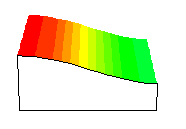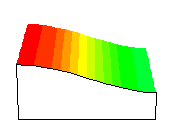 tides on a non-rotating earth |
 tides on a rotating earth |
If the earth would not be rotating, the experiment with the fish tanks on a table that moves back and forth would give an accurate picture of the tide. But the earth rotates, and the appropriate experiment to demonstrate the character of the tides is the experiment where the table undergoes circular forcing.
 tides on a non-rotating earth |
 tides on a rotating earth |
The animation compares the movement of the tidal wave on a non-rotating earth (left) with its movement on a rotating earth (right) The tidal bulge (high water) is red; low water is green.
Let us concentrate again on the non-rotating earth. The water moves back and forth, reaching the largest amplitudes at both ends of the tank. Note that half-way between the two ends the water level does not change; there is a line across the tank where it always stays at mean water level. This line is called a node. The volume of water on each side of the node changes continuously, so water has to be transported past the node. This means that horizontal movement (the tidal current) is largest at the node, in contrast to the ends of the tank, where the horizontal velocity has to vanish.
To summarize the situation on a non-rotating earth:
Tides take the form of a standing wave, with water moving back and forth. The tidal amplitude is largest at the end of basins, where the tidal current vanishes. It is zero at nodes, where the tidal current is largest. All places on one side of the node have high water at the same time, and all places on the other side of the node have high water half a tidal period later. |